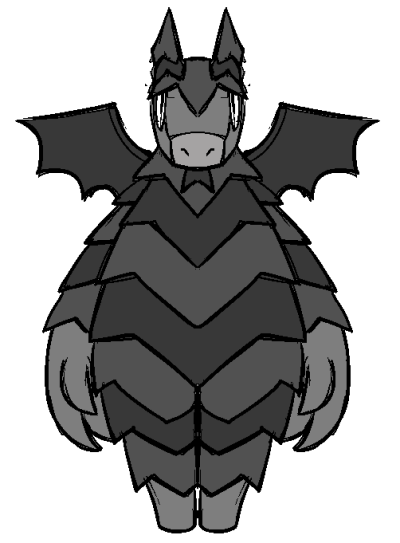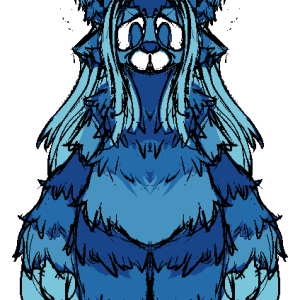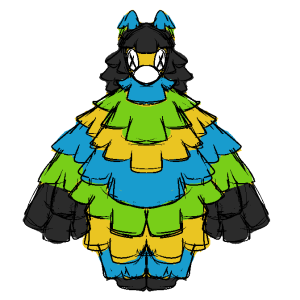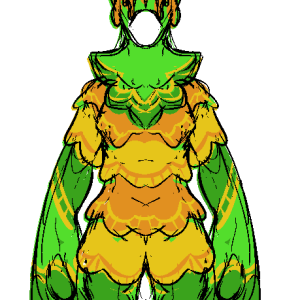Pinitelles
Name: Pinitelles
Creator: TBA
Home Zone: TBA
Project Appearances: Ashtray (Derry)
Species Development Thread: Species Development: Pinitelles
Table of Contents
Pintelles are a candy-based species with a variety of appearances.
Origin
It is currently unknown who created pintelles and where they originated.
Culture
Pinitelles are a primarily nomadic species that spend the majority of their time traveling and trading around the island clusters of southeast Morbit, though they can be found in regions all around the world.
Pinitelles are prone to shedding when sick, though the “fabric” wrapper and ruffles on their body do grow back fairly quickly.
Due to their ability to both shatter easily with significant force and heal just as easily and quickly, pinitelles tend to have a much more lackadaisical attitude towards injury and are less bothered by it than most species. Nomadic pinitelles travel in groups on large ships, typically pirate-like in nature, though definitely upgraded for the modern-day.
Rival pinitelle crews often get into duels, though sinking each others’ ships and taking actual lives is considered highly taboo, and many duels are satisfactorily ended with the temporary removal of a limb or two. Attacking the head is equally taboo, and is to be avoided at all costs outside of incredibly serious disputes.
Common weapons among dueling nomadic pinitelles are typically blunt, bashing weapons meant to help shatter their hard candy shells-usually bat, hammer, or mace-like in nature.
Traditionally, pinitelles enjoy sleeping in hammocks with heavy pillows and blankets, enough to cushion their candy shells and protect them from impacts.
Nomadic pinitelles are trained by their crews in whatever knowledge is deemed relevant, and many pick up knowledge from wherever they stop by on their travels. Stationary pinitelles typically pick up on whatever systems are the standard for the region/zone.
Pinitelles, for the most part, have grown used to living in fairly cramped housing due to living on boats for the majority of their existence, though some do prefer life on land.
Pinitelles are surprisingly effective in combat, though they prefer to fight each other than other species for a myriad of other reasons. Other species are less likely to follow their dueling code and potentially go for more permanent injuries, and it’s harder for a pinitelle to gauge how much damage anything will do to a species that isn’t made of candy- for better or for worse.
Pinitelles enjoy sharing stories of their travels with each other and other people they come across, and generally have something interesting to say if landing at port.
Appearance
Pinitelles have ruffled “fabric” layers on their thick bodies.
Their markings generally not very present aside from different colored ruffles, outside of the alibrije morph, which often has many patterns.
Their voices consist of honks, squeaks, and whistles.
Pintelles lack paw pads and tails. Although dragon morph is an exception with a tail.
Pintelles often have hair, though this takes the form of extra fabric ruffles.
Pinitelles range from 4’6-6’6 for “normal” adult height.
They have thick arms/hands and plantigrade legs.
Biology
Pinitelles do not have skeletons, muscles, nerves, organs, or blood.
Composed primarily of a candy-like substance of varying consistencies and qualities- some examples resembling taffy, liquid, creme filling, whipped cream, frosting, melted sprinkles, gummi candy, gel, or gum. This “candy” is technically organic and heals/regenerates if removed from the body, and hurts to remove/bleed out- though some materials are solid, and will not bleed.
Internal candy is kept within a thick, equally organic, “hard candy” shell that shatters evenly when hit with significant force. This candy shell becomes sticky when significantly wet, and can be stuck back together when broken. This shell heals incredibly fast, and most broken limbs can be reattached within an hour if held in place. The hard candy shell is covered in a deceptively organic, hydrophobic “fabric” wrapper that is as capable of healing as the rest of the pinitelle’s body. On top of the initial layer are layered fabric ruffles, which will grow out over time if not trimmed. These keep the hard candy layer from getting sticky.
Most pinitelle morphs have blunt, square teeth.
Pinitelles eat primarily candy and desserts, though they are capable of eating most other foods with minimal nutritional value.
Pinitelles have average energy levels.
A pinitelle shaking their ruffles is often seen as either a flirtatious or a threatening gesture based on context. Hitting the head in combat is to be avoided at all costs- while a pinitelle can hypothetically survive without their head, breaking or losing access to their eyes, mouth or nose can lead to a partial or full loss of sensory function. This is considered forbidden conduct in duels between pinitelles and is typically only ever seen in cases of extreme dispute or combat between a pinitelle and another species.
Pinitelles are capable of hearing even without their head, though no one is sure how or why. This does not extend to sight, scent, or speech, however.
Pinitelles typically have white sclera with pupils of varying shapes, with no limit as to what shape the pupil can take.
Pinitelle noses squeak when squeezed.
Life Cycle/Family Structure
Pinitelles reproduce sexually and have minimal sexual dimorphism.
Pinitelles give live birth and typically have 1 child at a time, referred to as a calf. Pinitelle calves are extremely fragile for the first 5 years of their lives and are typically either left on the shore with trusted family members or taught the ropes of nomadic life quickly while being protected by the entire crew.
Pinitelles value casual and committed relationships equally.
Leaving a crew is considered a large event, and requires much fanfare in terms of a positive event, and much melancholy in terms of a negative one.
Genetics
Pinitelle morphs are inspired by different kinds of pinata and sculpture.
Mixed morph children often have a blend of facial and horn shapes.
The first morph identified was the horse morph.
Pinitelle hybrids often have some degree of candy innards, sometimes leading to illness/death if this forms in a way that is particularly incompatible, fabric ruffles, large hands, and/or horns.
Common horror mutations that pinitelle experience include; carnivorous diets, hunger increase, size increase, extra eyes, claw growth, mood instability, teeth growth, candy poisoning, shell melting, fabric overgrowth/shedding
Morphs
Horse
The horse morph is based on horse and llama piñatas. They have thick, chunky hands, ear-like horns, and round noses.
Bull
The bull morph is based on bull and cow piñatas. They have thick, chunky hands, large, curving horns, and small noses, usually pierced.
Star
The star morph is based on star-shaped and abstract piñatas. They have clawed hands, many long horns, and muzzles with defined noses.
Alebrije
The Alebrije morph is based on wooden Alebrije sculptures. They have thick, chunky hands, exposed candy shell which resembles wood carvings and is hydrophobic to avoid degradation, thick horns, and a tapered snout with thick noses. They tend to be larger than most other morphs.
Dragon
The dragon morph is based on dragon-shaped piñatas. They have clawed hands, pointed horns, and wings. They have a large snout-shaped head with nostrils and a small forked tongue. They tend to be larger than most other morphs. Dragon morph pinitelles are prone to having spicy candy and candy slime within their internal cavity, with flavors such as cinnamon, chili, or tamarindo.













